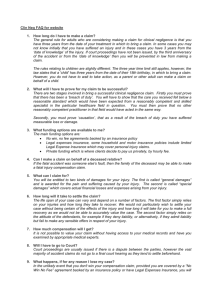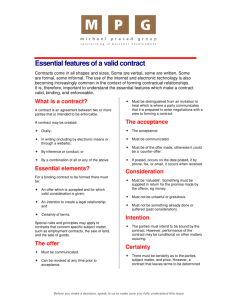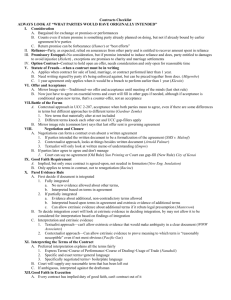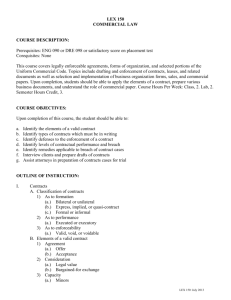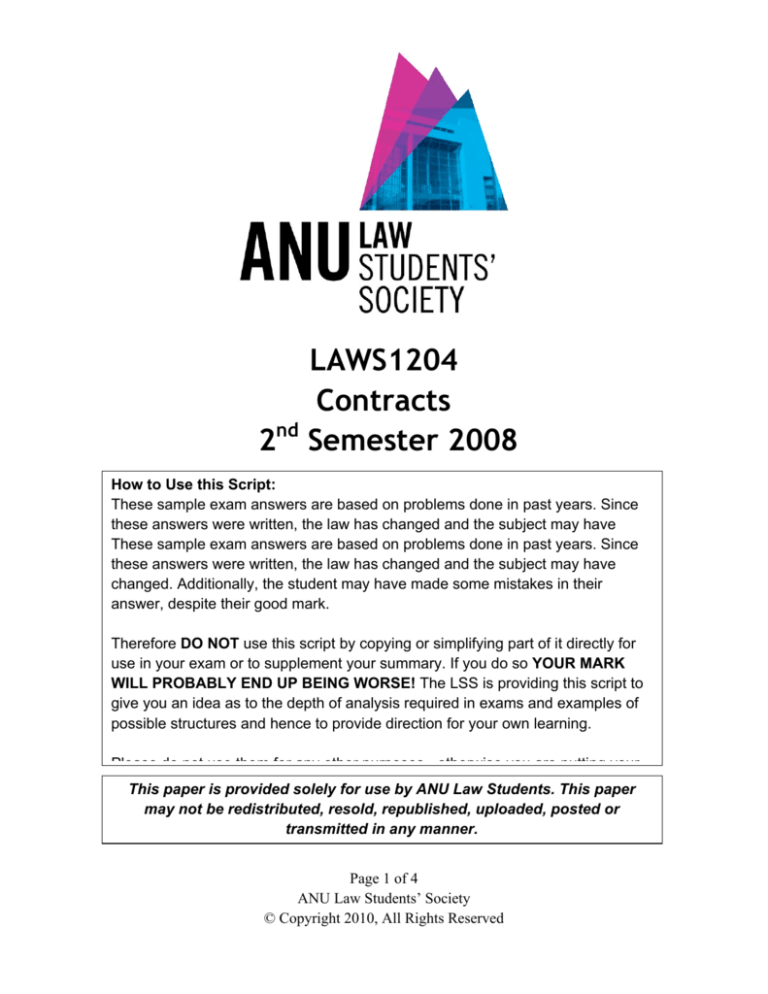
2nd
LAWS1204
Contracts
Semester 2008
How to Use this Script:
These sample exam answers are based on problems done in past years. Since
these answers were written, the law has changed and the subject may have
These sample exam answers are based on problems done in past years. Since
these answers were written, the law has changed and the subject may have
changed. Additionally, the student may have made some mistakes in their
answer, despite their good mark.
Therefore DO NOT use this script by copying or simplifying part of it directly for
use in your exam or to supplement your summary. If you do so YOUR MARK
WILL PROBABLY END UP BEING WORSE! The LSS is providing this script to
give you an idea as to the depth of analysis required in exams and examples of
possible structures and hence to provide direction for your own learning.
Please do not use them for any other purposes - otherwise you are putting your
academic
future
risk.
This paper
is at
provided
solely for use by ANU Law Students. This paper
may not be redistributed, resold, republished, uploaded, posted or
transmitted in any manner.
Page 1 of 4
ANU Law Students’ Society
© Copyright 2010, All Rights Reserved
Question 2 – D (75)
Harriet’s (H) rights and liabiulity in the circumstances will depend solely on the question of
whether Gabrielle (G) terminated lawfully. In order to ascertain whether G terminated lawfully,
we must analyse the facts.
1. Repudiation by H
The onus is on G to prove that H repudiated if G is to argue that she terminated lawfully Hs by
repudiation.
Repudiation is a situation where one party illustrates an intention to no longer be bound to their
obligations under the contract (Luna Park v Tramways). [ü] If G can prove that H repudiated by
showing her repudiatory intent, the contract is terminated lawfully upon election to terminate by
G.
However, what constitutes repudiatory intent here is clear: H failed to deliver on time a total of 3
times. This may prove repudiatory intent, but, after a notice was issued validly (for it included
all the essential elements of a valid notice as per Louinder v Leice, i.e. stipulate what the
wrongdoer must do to complete, specify a reasonable time to complete and set out the
consequences of non-compliance (termination)), H complied with it. [ü]
Therefore, seeing as H complied with G’s notice to complete on time, G cannot argue she validly
terminated on Hs repudiation.
Furthermore, repudiation is a serious matter not lightly inferred (Trawl Industries), and where
there is doubt the court will likely uphold the contract.
Therefore, Gs argument of repudiation would fail.
2. Was clause 3 a condition?
Despite H not being liable having not shown repudiatory intent, she may still be liable for Gs
damages if G can prove H breached the condition – clause 3.
Whether or not a clause will be a condition is a matter of construction (Luna Part). [ü]
Therefore, the test is that of Jordan CJ in Tramways: that of implied essentiality. This test
assesses the objective importance of the clause, and determines whether the clause goes “to the
root of the contract”.
Put simply, the test is this: would the innocent party have entered into the contract but for an
implied warranty (assurance) of strict performance of the promise? [ü] The test was affirmed in
Associated Newspaper v Bancks, so therefore applies here.
In applying the test, and construing the factual matrix surrounding the contract, it would seem
that G would not have entered into the contract but for the assurance that the grain contained
44% soybean protein per tonne. This is because G intended to on-sell the grain immediately, and
would therefore presumably need that level of protein.
Thus H would be liable for damages because G terminated lawfully by virtue of H breaching a
condition.
Page 2 of 4
ANU Law Students’ Society
© Copyright 2010, All Rights Reserved
However, should a court find that the facts do not prove CJ Jordan’s test, then G must prove the
clause was a condition by the serious effects of a serious breach.
3. Was clause 3 a condition because of serious breach?
An intermediate term such as clause 3 may be construed as a condition where the effects of the
breach of that term are serious (Ankar v National Westminster Finance).
Applying this rule, the seriousness of the breach may be Gs inability to on-sell the grain because
of low protein quantity, or effects on her reputation. However, this is purely speculative because
the facts presented do not give sufficient information to reach a conclusion. If the effects were
not serious, it would be a breach of warranty giving rise to damages.
It would be fair to say however that on balance H would be liable for damages to be paid to G by
virtue of breach of condition (cl3). Thus the question becomes one of assessment of damages.
4. Damages payable to G
Damages are a common law right that accrues following a breach of contract, and attempt to put
the innocent party in the position they would have been in had the contract been performed
(Dobinson v Herman). [ü]
In this case, G would claim damages for losses sustained from H’s late deliveries.
5. Can G claim for H’s breaches after affirming the contract?
The answer to this may be found in Shevill Builders: just because you affirm a contract, does not
mean you can’t claim damages for breaches. Thus G could claim for the breaches of contract.
[ü]
6. Can G claim for paying staff?
As a result of H’s breaches, G was required to pay her employees more than normal to deliver
the goods to her customers. Whether or not she can claim expectation damages (for loss of
expectation under the contract) is a matter of construction.
G must first prove loss – has the plaintiff suffered a loss as a result of the defendant’s actions? G
can prove the costs of paying her staff overtime. [ü]
Secondly, G must prove causation – was there a causal link between the D’s action and the
damage suffered? TO prove this element, G must prove that the loss would not have occurred
‘but for’ the breach of the contract (Reg Glass).
In these circumstances, a court would most likely find that G would not have had to pay overtime
but for the breach, thus proving the requisite causation.
Thirdly, G must prove that the losses sustained were not too remote. The test for this stems from
Hadley v Baxendale, and is the contemplatable loss test. Losses will be awarded where they are
naturally arising in the ordinary course of events. [ü]
To prove this, G would need to show that the loss she sustained was foreseen, in that the D
should have foreseen the loss was ‘likely to occur’ or was a ‘serious possibility’ if she breached
(Victoria Laundry). Indeed, a court may find that H should have foreseen that the loss was a
serious possibility if she breached, as thus award damages to G on the first limb of Hadley v
Baxendale.
Page 3 of 4
ANU Law Students’ Society
© Copyright 2010, All Rights Reserved
The second limb is that of special losses, or losses arising from a quirk of the contract. For that
to apply here, H would have to demonstrate that she had special knowledge of G’s business, and
does not apply in these circumstances.
Finally, G must have mitigated her loss, in that she took all reasonable steps to mitigate a loss
(Sotorios). It can be argued that G did this by paying her staff overtime to deliver the goods, thus
G mitigated her losses. [ü]
Conclusion
Having analysed the case and the requirements to successfully argue damages, it would appear
that H would be liable to pay G damages for losses sustained as a result of her breach (employee
expenses), as well as damages for breaching the contract.
This stems from the fact that G terminated lawfully (H breached a condition). The only question
remaining is whether H can claim payment for delivery the final goods. The answer to this is
most likely yes she can, because she complied with the contract to deliver the goods on time, and
thus payment falls due upon completion of the obligation (McDonald v Dennys Laschelles).
However, the amount awarded to her would most likely be reduced due to the fact that the goods
were ‘damaged’ in not containing the requisite level of protein.
Page 4 of 4
ANU Law Students’ Society
© Copyright 2010, All Rights Reserved

